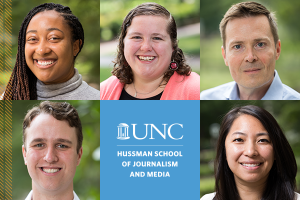Research Publication Roundup: March 2023

A vibrant and collaborative interdisciplinary research culture at the UNC Hussman School of Journalism and Media creates new knowledge, advances scholarship and helps reinvent media.
Four doctoral students authored or co-authored recently published articles on a wide range of topics, including religious and political communication, health communication and communication regulation. Another student presented at the American Academy of Advertising Conference in Denver. More details on these studies are listed below, along with a list of other recently published or presented scholarship by UNC Hussman faculty and students. Students pictured, clockwise from top left: LaRisa Anderson, Meredith Collins, Dan Malmer, Jessica Shaw, Evan Ringel.
RECENT PUBLICATIONS
Since the onset of COVID-19, live streaming has become a popular addition to contemporary church technologies. Prior to the pandemic, the author conducted interviews with six church leaders who represented two Austin, Texas-based churches of varying sizes, demographics, and resources. Interviews probed the meaning of community in live-streamed services compared to physical gatherings; interviews were then thematically analyzed using Campbell’s Religious-Social Shaping of Technology framework. Both churches used live streaming to serve three self-identified audiences: (1) members with accessibility needs, (2) the unchurched who needed an introduction to Christianity and (3) an imagined community of “burned” ex-churchgoers who still desired connection. Live streaming was unilaterally deployed to (1) meet people where they are, (2) promote healthy discourse and (3) expand the church. Implications for deploying technology in churches without critically examining affordances, disconnection and organizational mission are discussed.
Young adult cancer survivors struggle to make sense of their experience due to a lack of opportunities to both openly talk about cancer and engage in reflective activities. Entertainment narratives—or stories—may be an alternative to prompt these activities, as narratives can elicit self-expansion that may help fulfill intrinsic needs. One way to think about these narratives is as memorable messages. These messages stick with a person for a long period of time and may prompt the sense-making process through narrative communication. Little is known, though, about the use of entertainment narratives among young adult cancer survivors. Interviews with 25 young adult cancer survivors revealed that entertainment narratives were generally helpful if they provided distraction from cancer, were relatable and/or prompted participants to explore their emotions. These narratives were generally harmful if they worsened participants’ emotional state, either by exacerbating fears of death and/or depicting cancer unrealistically. The study’s findings suggest that entertainment narratives are memorable messages, and that helpful messages can increase feelings of competence and validation, which could promote psychological adaptation to the disease. Implications for future research are discussed.
To examine systematically how and how much political communication research has addressed race, the researchers analyzed author-supplied keywords in nine communication journals within three broad categories (political communication, generalist communication, and critical communication) over a 31-year period. Combining computational methods and traditional content analysis, the research team found that political communication and generalist communication journals engaged with race substantially less than critical communication journals. Furthermore, this level of engagement has remained essentially flat since the mid-1990s. Political communication journals discussed racism least among the three journal types. Finally, addressing race did not predict journal impact factor. Implications for the field are discussed.
This article examines the patchwork of regulatory approaches policymakers have used to govern the use of facial recognition technology. Without comprehensive federal legislation, state and local policymakers are left to fill the regulatory gap. The authors’ systematic analysis of FRT regulatory approaches identified five main categories of policymaking options: (1) agents of use, (2) limitations on use, (3) accountability of use, (4) evaluation of use and (5) enforcement of permitted use. Then, building on the novel empirical framework of regulatory options, the authors examine which types of FRT regulations would likely survive a First Amendment challenge. This taxonomy of regulatory approaches, coupled with a First Amendment analysis, offers valuable insights for policymakers and scholars.
To understand how people perceive and act on different types of misinformation, this study examined how health misinformation varying in falsity (fabrication versus misuse) and evidence type (statistical versus narrative) affects sharing and verification intentions. Within the context of COVID-19 vaccination, the authors conducted an online experiment, finding that misused misinformation was perceived as less false and resulted in higher sharing intentions than fabricated misinformation. Misinformation with narrative evidence, as compared to that with statistical evidence, was perceived as less false and led to lower verification intentions. These findings can be explained by psychological processes such as counterarguing and narrative engagement. These results can help practitioners develop dedicated misinformation literacy programs.
CONFERENCES
American Academy of Advertising Conference (AAA)
March 23–26, 2023 | Denver
Jeong, Y., Shaw, J., & Tran, D. (2023). Considering consumer privacy: Influences of ad, personal privacy, and product use factors on effectiveness of smart device ads [Conference presentation]. Denver, CO.